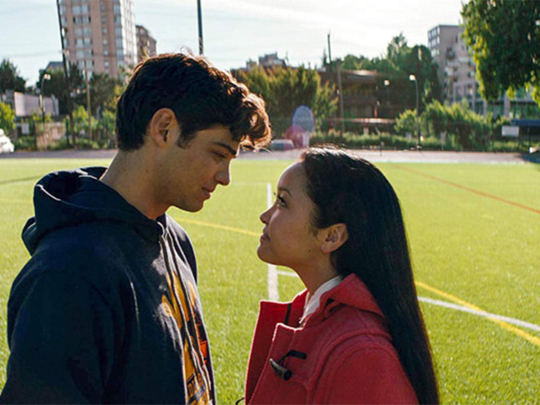
Teenage years are all about crushes. Crushes so deep you wanted to inhabit the other person, be inside their skin, see the world through their eyes. Before there was Pinterest or Tumblr, we used actual bulletin boards made out of cork, and we would pin our on-screen crushes on them with little pushpins. Mine had Dwayne Wayne from A Different World in his flip-top glasses, and Jordan Catalano from My So-Called Life, leaning against a locker. Oh, how I loved the way he leant.
But the truth is that teenage girls think far more about other girls than boys. When I was 13, my teen queen was Alicia Silverstone in her cutoffs and slip dresses, ribbed camisoles and combat boots. Those knee socks she wore with her yellow three-piece suit in Clueless. Every time Buffy the Vampire Slayer cut her hair, I cut mine too — from chunky layers to a bob. I even did the Season 3 baby bangs that work only on a certain type of hair. (Not mine.)
No matter how I did my hair, I was never going to look like any of my idols or any of the girls in my cherished Delia’s catalogue. No average girl would ever achieve that impossible ideal, but if she was white, she did see a glossier version of herself in movies and on magazine covers and TV. As an Asian-American girl, I didn’t have that experience.
The closest I got was Nicole Bilderback. You may not know her name, but if you saw her, you’d recognise her. She was on a few episodes of Dawson’s Creek, and a few episodes of Buffy the Vampire Slayer, where she was a Cordette — no actual name, just one of Cordelia’s minions. In Clueless, she was Cher’s Asian friend. Her characters didn’t have much back story, but she was always sparkly, always delivered her lines with panache. If Nicole was a teenage actress today, I’d like to think she’d be more than just a minor character. She’d be the star of a teen movie, because I would make it my mission to write one for her.
I started writing stories at a young age, but not once did it occur to me that I could grow up to be a writer. Who could I look to? My favourite authors were Ann M. Martin and E.L. Konigsburg and Judy Blume, Beverly Cleary and Lois Lowry and Norma Klein. They were all white women, and they seemed so stately to me, so elegant. A whole world away.
When I sold my first middle-grade novel in 2005, it wasn’t that common to put an author photo on the back flap, but 24-year-old Korean-American me insisted. I wanted Asian girls to see my face. And more than that, I wanted them to see what is possible.
My young-adult novel, To All the Boys I’ve Loved Before, is about a girl who writes secret love letters to boys when she wants to get over them. They’re for her eyes only — except one day, they all get sent out. Even before the book came out in 2014, there was interest in making a movie. But the interest died as soon as I made it clear the lead had to be Asian-American. One producer told me, as long as the actress captures the spirit of the character, age and race don’t matter. I said, well, her spirit is Asian-American. That was the end of that.
What would it have meant for me back then to see a girl who looked like me star in a movie? Not as the sidekick or romantic interest, but as the lead? Not just once, but again and again? Everything. There is power in seeing a face that looks like yours do something, be someone. There is power in moving from the sidelines to the centre.
Having a book made into a film is a career-changing moment for authors. But authors have little control over any aspect of the movie-making process. Once you hand over the rights, no one is obligated to listen to anything you say.
I ended up deciding to work with the only production company that agreed the main character would be played by an Asian actress. No one else was willing to do it. Still, I was holding my breath all the way up until shooting began because I was scared they would change their minds. They didn’t.
When it was time to talk about our heroine Lara Jean’s aesthetic, I made a mood board for the producers. I pinned pictures of girls on the streets of Seoul and Tokyo and Shanghai. Asian streetwear meets the 1990s with a dash of the 1960s. Of course I included a picture of my beloved Alicia Silverstone.
In the final scene of the movie, Lana Condor, who plays Lara Jean, wears a plaid, pleated skirt and knee socks. When she came running out of her trailer that day, she gave me a little curtsy and I felt like both a proud mum and 13-year-old me all over again.
I hope teenage girls see Lana Candor and feel the way I felt about my teen idols. Constance Wu, Awkwafina, Gemma Chan of Crazy Rich Asians, Kelly Marie Tran of Star Wars — I hope they all end up on someone’s bulletin board.
Because when you see someone who looks like you, it reveals what is possible. It’s not just maybe I could be an actress. It’s maybe I could be an astronaut, a fighter, a president. A writer. This is why it matters who is visible. It matters a lot. And for the girls of 2018, I want more. I want the whole world.
— New York Times News Service
Jenny Han is the author of To All the Boys I’ve Loved Before.










